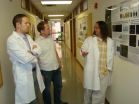(Press-News.org) DURHAM, N.C., AND SINGAPORE – A multi-national research team led by scientists at Duke-NUS Graduate Medical School has identified the reason why some patients fail to respond to some of the most successful cancer drugs.
Tyrosine kinase inhibitor drugs (TKIs) work effectively in most patients to fight certain blood cell cancers, such as chronic myelogenous leukemia (CML), and non-small-cell lung cancers (NSCLC) with mutations in the EGFR gene.
These precisely targeted drugs shut down molecular pathways that keep these cancers flourishing and include TKIs for treating CML, and the form of NSCLC with EGFR genetic mutations.
Now the team at Duke-NUS Graduate Medical School in Singapore, working with the Genome Institute of Singapore (GIS), Singapore General Hospital and the National Cancer Centre Singapore, has discovered that there is a common variation in the BIM gene in people of East Asian descent that contributes to some patients' failure to benefit from these tyrosine kinase inhibitor drugs.
"Because we could determine in cells how the BIM gene variant caused TKI resistance, we were able to devise a strategy to overcome it," said S. Tiong Ong, M.B.B. Ch., senior author of the study and associate professor in the Cancer and Stem Cell Biology Signature Research Programme at Duke-NUS and Division of Medical Oncology, Department of Medicine, at Duke University Medical Center.
"A novel class of drugs called the BH3-mimetics provided the answer," Ong said. "When the BH3 drugs were added to the TKI therapy in experiments conducted on cancer cells with the BIM gene variant, we were able to overcome the resistance conferred by the gene. Our next step will be to bring this to clinical trials with patients."
Said Yijun Ruan, Ph.D., a co-senior author of this study and associate director for Genome Technology and Biology at GIS: "We used a genome-wide sequencing approach to specifically look for structural changes in the DNA of patient samples. This helped in the discovery of the East Asian BIM gene variant. What's more gratifying is that this collaboration validates the use of basic genomic technology to make clinically important discoveries."
The study was published online in Nature Medicine on March 18.
If the drug combination does override TKI resistance in people, this will be good news for those with the BIM gene variant, which occurs in about 15 percent of the typical East Asian population. By contrast, no people of European or African ancestry were found to have this gene variant.
"While it's interesting to learn about this ethnic difference for the mutation, the greater significance of the finding is that the same principle may apply for other populations," said Patrick Casey, Ph.D., senior vice dean for research at Duke-NUS and James B. Duke Professor of Pharmacology and Cancer Biology. "There may well be other, yet to be discovered gene variations that account for drug resistance in different world populations. These findings underscore the importance of learning all we can about cancer pathways, mutations, and treatments that work for different types of individuals. This is how we can personalize cancer treatment and, ultimately, control cancer."
"We estimate that about 14,000 newly diagnosed East Asian CML and EGFR non-small-cell lung cancer patients per year will carry the gene variant," Ong said. "Notably, EGFR NSCLC is much more common in East Asia, and accounts for about 50 percent of all non-small-cell lung cancers in East Asia, compared to only 10 percent in the West."
The researchers found that drug resistance occurred because of impaired production of BH3-containing forms of the BIM protein. They confirmed that restoring BIM gene function with the BH3 drugs worked to overcome TKI resistance in both types of cancer.
"BH3-mimetic drugs are already being studied in clinical trials in combination with chemotherapy, and we are hopeful that BH3 drugs in combination with TKIs can actually overcome this form of TKI resistance in patients with CML and EGFR non-small-cell lung cancer," Ong said. "We are working closely with GIS and the commercialization arm of the Agency for Science, Technology & Research (A*STAR), to develop a clinical test for the BIM gene variant, so that we can take our discovery quickly to the patient."
###
The major contributors to the study include additional researchers and teams from the Duke-NUS Graduate Medical School, Genome Institute of Singapore (Dr. Yijun Ruan and Dr. Axel Hillmer), Singapore General Hospital (Dr. Charles Chuah), and National Cancer Centre Singapore (Dr. Darren Wan-Teck Lim).
In addition, the investigators also received important contributions from Akita University Graduate School of Medicine, Japan (Dr. Naoto Takahashi), the Cancer Science Institute of Singapore (Dr. Ross Soo), the National University Cancer Institute of Singapore (Drs. Liang Piu Koh and Tan Min Chin), the Yong Loo Lin School of Medicine, National University of Singapore (Dr. Seet Ju Ee), the University of Bonn, Germany (Dr. Markus Nöthen), the University of Malaya (Dr. Veera Nadarajan), and the University of Tokyo, Japan (Dr. Hiroyuki Mano).
The study was supported by grants from the National Medical Research Council (NMRC) of Singapore; Biomedical Research Council (BMRC) of A*STAR, Singapore; Genome Institute of Singapore; Singapore General Hospital; and two NMRC Clinician Scientist Awards to Dr. Ong and Dr Chuah.
END
DURHAM, N.C. -- Duke University engineers believe that continued advances in creating ever-more exotic and sophisticated man-made materials will greatly improve their ability to control light at will.
The burgeoning use of metamaterials in the field of optics does not rely on the limited set of materials found in nature, but rather man-made constructs that can be designed to control light's many properties. This control is gained by use of metamaterials, which are not so much single substances but entire man-made structures that can be engineered to exhibit properties ...
As we most of us already know, aging usually means we'll experience more problems with our hearing, vision and motor skills. In order to grow older safely, we must first recognize our vulnerabilities. Once we do this, we can adapt our behavior in order to create a safer environment for ourselves and everyone else.
The following statistics shed light on the special safety issues facing seniors both behind the wheel and when walking around as pedestrians.
Safety Issues for Senior Drivers/Pedestrians
(Note: In 2009, approximately 40 million Americans were age 65 and ...
A paper published online today in Nature describes the results of using bone marrow transplant (BMT) to replace faulty immune system cells in models of Rett Syndrome. The procedure arrested many severe symptoms of the childhood disorder, including abnormal breathing and movement, and significantly extended the lifespan of Rett mouse models. Exploring the function of microglia deficient in methyl-CpG binding protein 2 (Mecp2), the protein encoded by the "Rett gene," principal investigator Jonathan Kipnis, Ph.D. and his team at the University of Virginia School of Medicine ...
House mice (Mus musculus) happily live wherever there are humans. When populations of humans migrate the mice often travel with them. New research published in BioMed Central's open access journal BMC Evolutionary Biology has used evolutionary techniques on modern day and ancestral mouse mitochondrial DNA to show that the timeline of mouse colonization matches that of Viking invasion.
During the Viking age (late 8th to mid 10th century) Vikings from Norway established colonies across Scotland, the Scottish islands, Ireland, and Isle of Man. They also explored the north ...
Microglia are the first line defence of the brain and are constantly looking for infections to fight off. Overactive microglia can cause uncontrolled inflammation within the brain, which can in turn lead to neuronal damage. New research published in BioMed Central's open access journal Journal of Neuroinflammation shows that, honokiol (HNK) is able to down-regulate the production of pro-inflammatory cytokines and inflammatory enzymes in activated microglia via Klf4, a protein known to regulate DNA.
Scientists from the National Brain Research Centre, Manesar, India, used ...
A 'see-sawing' atmosphere over 2.5 billion years ago preceded the oxygenation of our planet and the development of complex life on Earth, a new study has shown.
Research, led by experts at Newcastle University, UK, and published today in the journal Nature Geoscience, reveals that the Earth's early atmosphere periodically flipped from a hydrocarbon-free state into a hydrocarbon-rich state similar to that of Saturn's moon, Titan.
This switch between "organic haze" and a "haze-free" environment was the result of intense microbial activity and would have had a profound effect ...
Marine Protected Areas (MPAs) are providing sea turtles with an ideal habitat for foraging and may be keeping them safe from the threats of fishing. A study by an international team of scientists led by the University of Exeter, published today (Thursday 15 March), shows that 35 per cent of the world's green turtles are found within MPAs. This is much higher that would be expected as only a small proportion of shallow oceans are designated as MPAs.
MPAs are areas of ocean in which marine activities such as fishing are restricted. Regulated by governments and NGOs, in ...
A study recently released by the University of Maryland found that pedestrian fatalities are on the rise due to distractions from headphone use. The majority of incidents were found among men younger than 30 who lived in urban areas.
The issue is that headphones playing music directly in pedestrians' ears may hinder their ability to hear oncoming car horns, revving engines, beeping crosswalk lights and even blaring train whistles. The study was conceived after a train killed a teenager wearing headphones while crossing railroad tracks. The teenager's music had drowned ...
Einstein's theory of gravity and quantum physics are expected to merge at the Planck-scale of extremely high energies and on very short distances. At this scale, new phenomena could arise. However, the Planck-scale is so remote from current experimental capabilities that tests of quantum gravity are widely believed to be nearly impossible. Now an international collaboration between the groups of Caslav Brukner and Markus Aspelmeyer at the University of Vienna and Myungshik Kim at Imperial College London has proposed a new quantum experiment using Planck-mass mirrors. Such ...
While millions of accounting professionals are working the midnight oil to get Americans' tax returns complete for Uncle Sam, a few hundred accountants with brand new skills are helping small business owners improve their profits, while creating the businesses and lives of their dreams. These accountants are members of a brand new group called Accountant's Accelerator that's led by accounting industry veteran Sandi Smith Leyva. Coaching and especially group coaching programs such as Accountant's Accelerator is relatively new to the accounting profession; especially for ...



